 This year marks the centennial of the Panama Canal. With its opening in 1914, seagoing transit between the Atlantic and Pacific Oceans was radically transformed. Before “the trench” was dug, ships seeking to cross the Americas needed to circumnavigate South America — a time-consuming journey of 8,000 or so miles that included the rounding of that continent at the treacherous Cape Horn. The canal, however, is just 48.2 miles long and can be traversed in complete safety in 10 hours or less. It was a stupendous achievement, and in 1994 the American Society of Civil Engineers recognized it as one of the Seven Wonders of the Modern World. (The other works named to that list include the Channel Tunnel; the CN Tower; the Empire State Building; the Golden Gate Bridge; the Itaipu Dam; and the Netherlands North Sea Protection Work.) In November 2013, I experienced this modern wonder firsthand.
This year marks the centennial of the Panama Canal. With its opening in 1914, seagoing transit between the Atlantic and Pacific Oceans was radically transformed. Before “the trench” was dug, ships seeking to cross the Americas needed to circumnavigate South America — a time-consuming journey of 8,000 or so miles that included the rounding of that continent at the treacherous Cape Horn. The canal, however, is just 48.2 miles long and can be traversed in complete safety in 10 hours or less. It was a stupendous achievement, and in 1994 the American Society of Civil Engineers recognized it as one of the Seven Wonders of the Modern World. (The other works named to that list include the Channel Tunnel; the CN Tower; the Empire State Building; the Golden Gate Bridge; the Itaipu Dam; and the Netherlands North Sea Protection Work.) In November 2013, I experienced this modern wonder firsthand.
A very brief history of the canal
From groundbreaking to completion, the creation of this engineering marvel took over three decades. It was initially undertaken by France in 1880, but the French efforts petered out in the 1890s. In 1903 Panama achieved independence from Colombia after a rebellion supported by the United States, and in 1904 the United States assumed control of the project to build the canal. The U.S. formally took over the construction after entering into a treaty that also gave it control over the geographic area known as the Panama Canal Zone. (That Zone consists of the canal itself as well as land extending several miles from either side of it, but excludes the cities of Panama City and Colón. Pursuant to a subsequent treaty signed by U.S. President Jimmy Carter in 1977, the U.S. ceded the Panama Canal Zone back to the Republic of Panama effective January 1, 2000.) Construction of the canal was finally concluded in 1913, and it opened to maritime traffic in the following year.
The creation of the canal proved costly, and not just monetarily. Tens of thousands of the workers on the project died while it was being built. For the vast majority of those fatalities, the cause of death was either malaria or yellow fever; those two diseases also resulted in the hospitalizations of additional tens of thousands of laborers. It was during the time period of the canal’s construction that mosquitoes were first identified as the transmitters of malaria and yellow fever, and by the time of the completion of the project, public health officials had made great strides in reducing the incidences of both diseases in Panama.
Cruising the canal
When I travel, I generally enjoy taking cruises on local bodies of water such as rivers; and the cruise on which I embarked in Panama was a unique variation on that theme. Visitors can choose a full-day tour through the entire length of the canal, or a shorter excursion that still provides the experience of passing through two of the canal’s three locks. I opted for the more abbreviated version of the tour — partly because it didn’t require me to awaken as early on a Saturday morning. 🙂
My tour set off in the middle of the canal, and proceeded towards the Pacific Ocean. You may be surprised to learn that while the Pacific Ocean is generally located to the west of the Atlantic Ocean, the course of the canal from the Atlantic to the Pacific is a winding route that generally follows a southeasterly direction, rather than going from east to west. (This results from the east-west orientation of the Isthmus of Panama that the canal bisects.) Conversely, Atlantic-bound vessels chart a northwesterly course through the canal.
Highlights along the shore
Among the points of interest on my tour, other than the waterway itself, were a prison and a museum. We floated past El Renacer Prison, the correctional facility where former Panamanian dictator Manuel Noriega is living out his days. We weren’t informed whether Mr. Noriega’s cell provides its occupant with a water view. 🙂
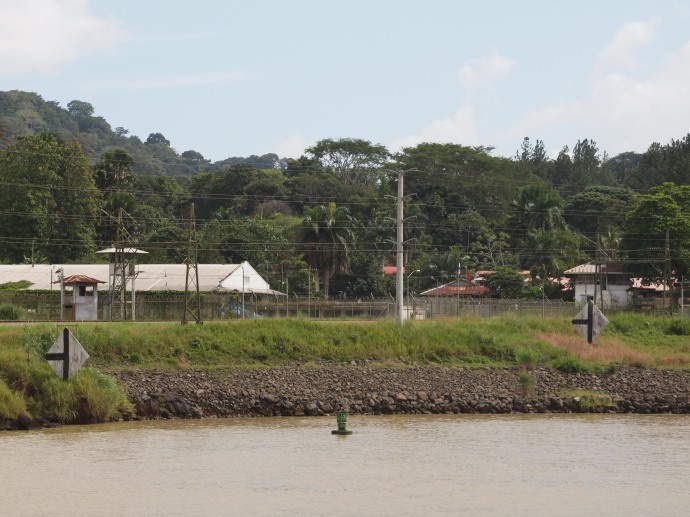
Orange is the new black for Manuel Noriega, who is one of the inmates in El Renacer Prison on the Panama Canal.
We also passed by a colourful museum designed by legendary architect Frank Gehry. It’s called the Biodiversity Museum: Panama Bridge of Life, and is also known as the Biomuseo.
The Biomuseo isn’t actually on the canal; it’s on a strip of land in Panama City called the Amador Causeway, which juts out into Panama Bay. We cruised past it after we’d already emerged from the Pacific Ocean terminus of the canal.
Making our way through the locks
At the heart of the canal are the locks. They work as follows: A vessel making its way through the canal doesn’t remain at sea level the entire way, because if the entire canal was at sea level, the resulting currents would be too dangerous. Rather, during the course of the journey, the ship is gradually lifted and then lowered. During the middle portion of its passage, as it sails through Gatun Lake (an artificial lake that’s one of the byproducts of the digging of the canal), the ship will be 85 feet above sea level. The locks are the means by which a ship is transferred between sections of the canal that are at different elevations.
A lock contains a gated compartment that the ship enters. After the ship has entered the compartment, the gates behind it swing shut and are sealed. Depending on the direction in which the boat is heading, water is either pumped into the compartment, to raise the boat to a higher level; or emptied out of the compartment to allow the boat to descend to a lower level. Once the adjustment in water level has been made, the gates in front of the boat swing open and the boat can continue on its way.
The canal’s locks contain two parallel shipping lanes, so they can handle traffic in both directions simultaneously. Additionally, an expansion project is underway that will add one more set of locks. The new locks will be wider and deeper than the lanes in the existing locks, and will therefore allow the canal to accommodate larger ships than are currently capable of fitting into its locks. They will also expand the overall capacity of the canal and allow more ships to use it. As of this writing, the third lane of the Panama Canal is expected to open in late 2015.
Immediately below are a couple of photos that I took from my boat as we went through the Miraflores Locks — a dual set of locks near the canal’s Pacific Ocean terminus.
For a more dynamic view of the experience, have a look at this brief video that shows the highlights of my boat’s progress through the Miraflores Locks:
If you continue in the direction in which we were proceeding, after exiting the Miraflores Locks, you’ll pass under the Bridge of the Americas, one of two bridges that span the width of the canal; and then you’ll reach the Pacific Ocean. Here’s what the Bridge of the Americas looks like:

The Bridge of the Americas is one of two bridges that permit the crossing of the canal by automobile.
This bridge is part of the Pan American Highway, an approximately 30,000 mile network of roads that extends from Alaska to Argentina (but which doesn’t connect North America with South America, due to a roughly 60 mile interruption called the Darién Gap that covers the border between Panama and Colombia). The view of the bridge seen here is looking away from the Pacific Ocean, after my boat had passed through the Miraflores Locks and ridden under the bridge.
Also at the Miraflores Locks is a visitor’s center. Inside, you can learn more about the canal and how it works. It also contains observation decks from which you can look down upon the canal and watch vessels making their way through it. On the day after my cruise through the canal, I checked out the visitor’s center at Miraflores Locks. The next series of photos was taken from the topmost of its viewing platforms.
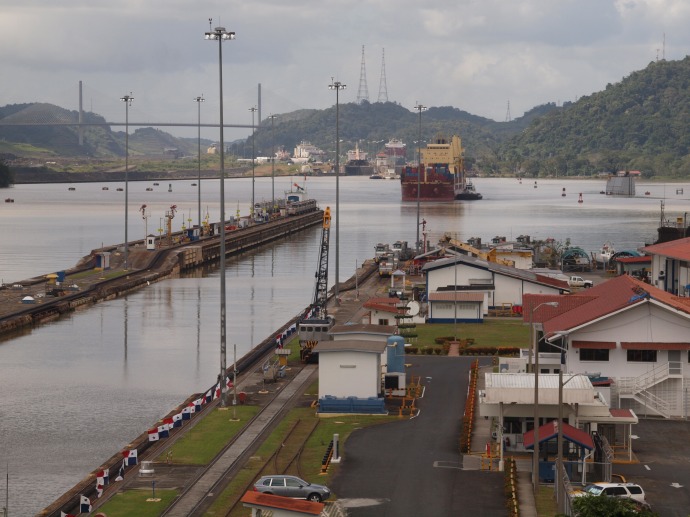
As viewed from the visitor’s center, a Pacific-bound container ship approaches the Miraflores Locks.
A museum about the canal
In addition to the canal itself, I visited the Museo del Canal Interoceánico de Panamá (Panama Interoceanic Canal Museum) in Panama City. The museum provides a comprehensive overview of the construction and history of the canal. It’s in the Casco Viejo (Old City) section of town; and it occupies a historic building.
The museum is informative and displays some interesting artifacts related to the canal and its construction. The one drawback for English-speaking visitors (or at least those who aren’t fluent in Spanish) is that all the signage is in Spanish. You can rent an audio guide that provides English-language narration covering a portion of the museum’s exhibits, and much of what you’re seeing can otherwise be figured out from context. But I did feel that I wasn’t able to learn as much as I would have if English translations of the museum’s plaques had been provided. For example, the museum had a temporary exhibition on the discovery of the Pacific Ocean and the effects of that discovery on the Age of Exploration. The subject matter of that exhibition is fascinating to me, but I got very little out of the presentation due to the Spanish-only signage. (That temporary exhibition wasn’t covered by the audio guide.) Overall, though, I enjoyed my visit to the museum and felt that it enhanced my appreciation of the Panama Canal and my understanding of how it came to be.
Parting thoughts
It was under President Theodore Roosevelt that the United States took the initiative in completing the Panama Canal. President Roosevelt observed that “[a] finer body of men has never been gathered by any nation than the men who have done the work of building the Panama Canal,” and that those men “have made not only America but the whole world their debtors by what they have accomplished.” Indeed, the product of those workers’ labors has had a profound impact on the world. A century after the first ship passed through its locks, the canal remains a vital part of global commerce, and it stands as one of the most impressive accomplishments in the history of civil engineering. Taking a cruise on the canal is one of the coolest things I’ve done in my travels. (Of course, singing karaoke in Panama was pretty awesome too.) 🙂
Would you like to ride through the Panama Canal?
Click here to follow me on Twitter! And click here to follow me on Instagram!



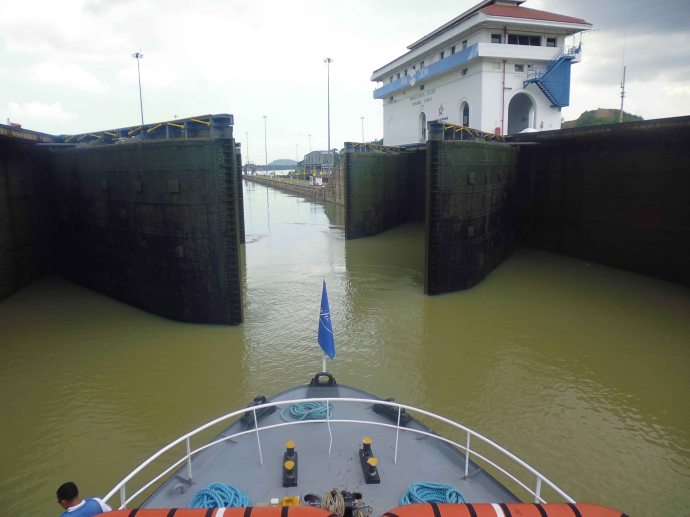
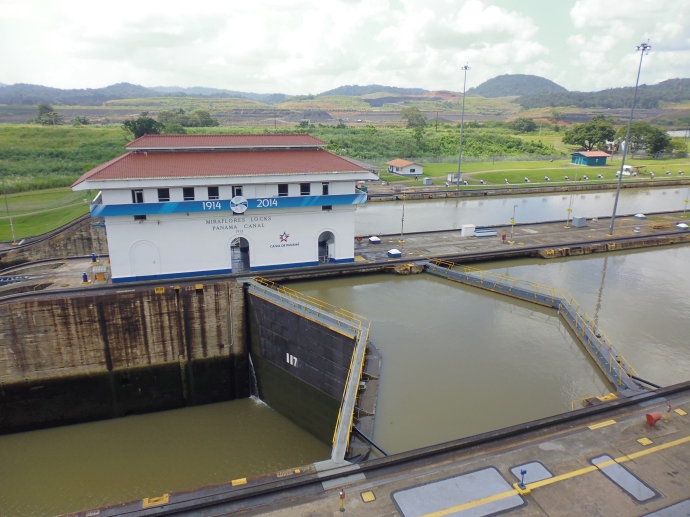
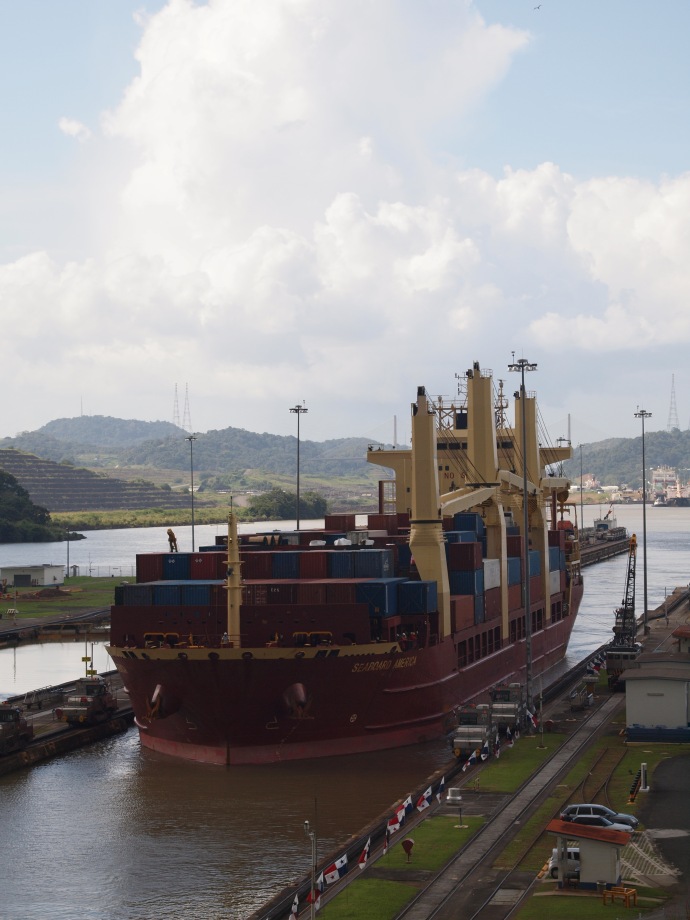

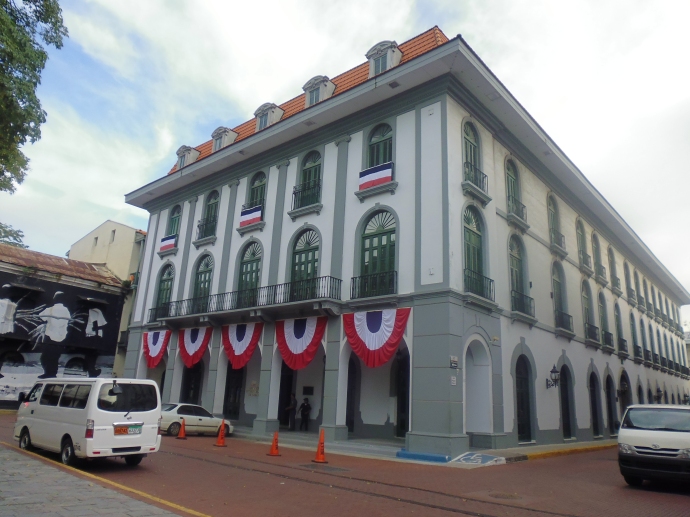



This is brilliant! I have been obsessed with the two canals for years and would love to see them in the flesh one day. Seeing two oceans in one day – can’t often say that 🙂
LikeLike
@codowd: I only saw one ocean that day, since I started in the middle of the canal. To be honest, even the partial tour involves a lot of sitting around (while you’re waiting for each of the locks to be ready for your boat, and then during the pumping process), so the full-day tour might have long intervals of boringness. 🙂 With that said, going through the canal was an amazing experience.
You say that you’ve been obsessed with TWO canals; what’s the other one (besides Panama)?
LikeLike
Loved your article and have a couple regarding Panama and surrounding areas coming soon. My husband and I spend much time in Boquete, but always bring new friends to Miraflores for the excitement of watching the ships go through the canal. Have you ever used the app (I can’t remember the name right now) that tells you the name of the ship and all pertinent details of what ship is going through the canal at that particular time? I was on a Panama Canal cruise 7 years ago and just cannot believe how large the city has grown, and so fast. They are enjoying their rise to metropolitan city fame just as much as I enjoy watching it for them. Best wishes on future travels. 😉
LikeLike
@Melody: I haven’t used that app. Sounds interesting, though.
I was surprised at how large Panama City was.
LikeLike
The whole experience sounds incredible! The Frank Gehry museum looks really amazing as well. I’m sure it doesn’t have my favorite mascots (Pee and Poop) from the museum in India that you visited, but the architecture is really incredible.
LikeLike
@Jen: It really was an incredible experience. I can’t confirm whether the Biodiversity Museum has Pee and Poo, since I didn’t go inside. 🙂
LikeLike
This must have been an incredible experience. I saw the ferries going through the Miraflores locks, but actually going through it must have been ace!
LikeLike
@Claudia: It really was a great experience!
LikeLike
Amazing stuff, would love to visit.
Cheers.
LikeLike
@Steven: You should! It’s great to see a wonder like this in person.
LikeLike
One day, Senor, one day.
LikeLike
Absolutely loved that you included a video. Although I’m sure it’s more amazing in person it allowed me to feel as though I were there. Thanks for all the wealth of information you provided. This is an amazing piece of history that I now know a lot more about!
LikeLike
@thegetawaygal: I’m glad you enjoyed the video! Yes, the making of the canal is, in my opinion, a fascinating bit of history — and a great example of man triumphing over some great challenges!
LikeLike
What a cool experience! I’ve never been through locks of any kind but at least I can say I’ve either seen or been through or across many of the other Modern Wonders.
LikeLike
@ladyofthezoos: It was a pretty cool experience to ride through the locks. (I had done that before on the Nile River in Egypt actually, but going through THESE locks was even cooler.)
LikeLiked by 1 person
How cool is this! I’d love to see this in person!
LikeLike
@MK: I hope you will get the chance to see it in person!
LikeLike
I love the Biodiversity Museum building. I’d like to go inside, too.
LikeLike
@Zofia: It’s certainly an interesting-looking building!
LikeLike
I still can’t believe the US held onto the canal until only recently. I agree that it’s modern marvel and a cruise down it would be an incredible experience. Thanks for brining us along 😉
LikeLike
@Ryan: Well, the U.S. did do all the work in getting the canal built after the French pulled out. 🙂 And if President Carter hadn’t signed the treaty in the 1970s, the U.S. might still have control of the Canal Zone today!
LikeLike